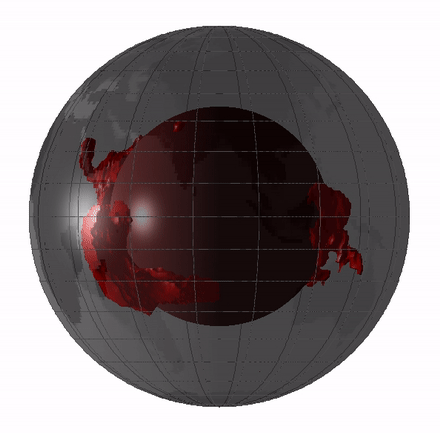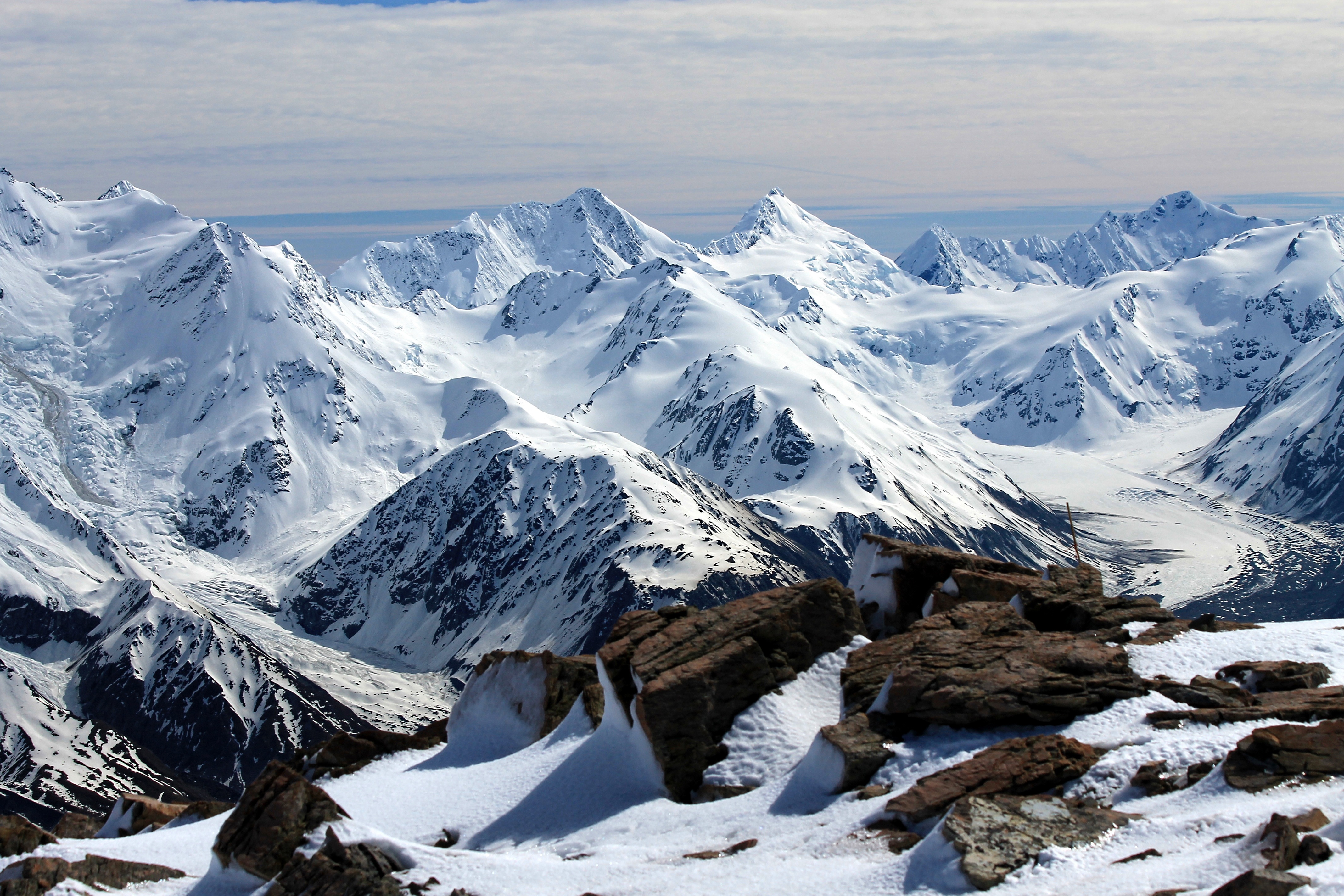|
Hikurangi Plateau
The Hikurangi Plateau is an oceanic plateau in the South Pacific Ocean east of the North Island of New Zealand. It is part of a large igneous province (LIP) together with Manihiki and Ontong Java, now located and north of Hikurangi respectively. Mount Hikurangi, in Māori mythology the first part of the North Island to emerge from the ocean, gave its name to the plateau. Geological setting The Hikurangi Plateau covers approximately and reaches below sea level. Hikurangi Plateau is cut by the Hikurangi Channel, a 2000 km abyssal channel that starts at Kaikōura and runs along the Hikurangi Trough as far as the Māhia Peninsula before crossing the plateau and ending in the South-west Pacific abyssal plain. Tectonic evolution Two models have been proposed for the formation of Hikurangi. It could be derived from the mantle plume that caused the break-up of Gondwana and the separation of Zealandia from Antarctica 107 Ma. Alternatively, it could have formed ... [...More Info...] [...Related Items...] OR: [Wikipedia] [Google] [Baidu] |
Basalt
Basalt (; ) is an aphanite, aphanitic (fine-grained) extrusive igneous rock formed from the rapid cooling of low-viscosity lava rich in magnesium and iron (mafic lava) exposed at or very near the planetary surface, surface of a terrestrial planet, rocky planet or natural satellite, moon. More than 90% of all volcanic rock on Earth is basalt. Rapid-cooling, fine-grained basalt is chemically equivalent to slow-cooling, coarse-grained gabbro. The eruption of basalt lava is observed by geologists at about 20 volcanoes per year. Basalt is also an important rock type on other planetary bodies in the Solar System. For example, the bulk of the plains of volcanism on Venus, Venus, which cover ~80% of the surface, are basaltic; the lunar mare, lunar maria are plains of flood-basaltic lava flows; and basalt is a common rock on the surface of Mars. Molten basalt lava has a low viscosity due to its relatively low silica content (between 45% and 52%), resulting in rapidly moving lava flo ... [...More Info...] [...Related Items...] OR: [Wikipedia] [Google] [Baidu] |
Greater Ontong Java Event
The Ontong Java Plateau (OJP) is a massive oceanic plateau located in the southwestern Pacific Ocean, north of the Solomon Islands. The OJP was formed around (Ma), with a much smaller volcanic event around 90 Ma. Two other southwestern Pacific plateaus, Manihiki and Hikurangi, now separated from the OJP by Cretaceous oceanic basins, are of similar age and composition and probably formed as a single plateau and a contiguous large igneous province together with the OJP. When eruption of lava had finished, the Ontong Java–Manihiki–Hikurangi plateau covered 1% of Earth's surface and represented a volume of of basaltic magma. This "Ontong Java event", first proposed in 1991, represents the largest volcanic event of the past 200 million years, with a magma eruption rate estimated at up to per year over 3 million years, for a total several times larger than the Deccan Traps. The smooth surface of the OJP is punctuated by seamounts such as the Ontong Java Atoll, one of the la ... [...More Info...] [...Related Items...] OR: [Wikipedia] [Google] [Baidu] |
Geography Of The New Zealand Seabed
Geography (from Ancient Greek ; combining 'Earth' and 'write', literally 'Earth writing') is the study of the lands, features, inhabitants, and phenomena of Earth. Geography is an all-encompassing discipline that seeks an understanding of Earth and world, its human and natural complexities—not merely where objects are, but also how they have changed and come to be. While geography is specific to Earth, many concepts can be applied more broadly to other Astronomical object, celestial bodies in the field of planetary science. Geography has been called "a bridge between natural science and social science disciplines." Origins of many of the concepts in geography can be traced to Greek Eratosthenes of Cyrene, who may have coined the term "geographia" (). The first recorded use of the word Geography (Ptolemy), γεωγραφία was as the title of a book by Greek scholar Claudius Ptolemy (100 – 170 AD). This work created the so-called "Ptolemaic tradition" of geography, w ... [...More Info...] [...Related Items...] OR: [Wikipedia] [Google] [Baidu] |
Large Low-shear-velocity Provinces
Large low-shear-velocity provinces (LLSVPs), also called large low-velocity provinces (LLVPs) or superplumes, are characteristic structures of parts of the lowermost mantle, the region surrounding the outer core deep inside the Earth. These provinces are characterized by slow shear wave velocities and were discovered by seismic tomography of deep Earth. There are two main provinces: the African LLSVP and the Pacific LLSVP, both extending laterally for thousands of kilometers and possibly up to 1,000 kilometres vertically from the core–mantle boundary. These have been named Tuzo and Jason respectively, after Tuzo Wilson and W. Jason Morgan, two geologists acclaimed in the field of plate tectonics. The Pacific LLSVP is across and underlies four hotspots on Earth's crust that suggest multiple mantle plumes underneath. These zones represent around 8% of the volume of the mantle, or 6% of the entire Earth. Other names for LLSVPs and their superstructures include superswells, ... [...More Info...] [...Related Items...] OR: [Wikipedia] [Google] [Baidu] |
Campbell Plateau
The Campbell Plateau is a large oceanic plateau south of New Zealand and the Chatham Rise. It originated in the Gondwanan breakup and is part of Zealandia, a largely submerged continent. The above sea level parts of the plateau — the Bounty Islands, Antipodes Islands, Auckland Islands and Campbell Island — form part of the New Zealand Subantarctic Islands which were declared a World Heritage Site in 1998. Large parts of the Campbell Plateau lie less than 1000 m below sea level. It rises to 500 m at the Pukaki Rise and emerges above sea level at the Auckland and Campbell Islands. Covering an area of , the Campbell Plateau has a gently undulating bathymetry with major rises trending east–west: Campbell Island Rise, Pukaki Rise, and Bounty Island Ridge. There are two near-parallel rises on the western margin: Stewart Island–Snare Island Rise and Auckland Island platform. The continental slopes are steep on western and southern margins while the norther ... [...More Info...] [...Related Items...] OR: [Wikipedia] [Google] [Baidu] |
1931 Hawke's Bay Earthquake
The 1931 Hawke's Bay earthquake, also known as the Napier earthquake, occurred in New Zealand at 10:47am on 3 February, killing 256,The exact number of deaths varies according to different sources; the ''New Zealand Listener'' article cited below gives 258 deaths, but the Bateman ''New Zealand Encyclopedia'' gives 256. The difference is due to two people "missing" and presumed dead. Some articles add these two to the death toll, while others do not. injuring thousands and devastating the Hawke's Bay (region), Hawke's Bay region. It remains New Zealand's deadliest natural disaster. Centred 15 km north of Napier, New Zealand, Napier, it lasted for two and a half minutes and had a magnitude of 7.8 (7.7 ). There were 525 aftershocks recorded in the following two weeks, with 597 being recorded by the end of February. The main shock could be felt in much of New Zealand, with reliable reports coming in from as far south as Timaru, on the east coast of the South Island. Tectonic ... [...More Info...] [...Related Items...] OR: [Wikipedia] [Google] [Baidu] |
Moment Magnitude Scale
The moment magnitude scale (MMS; denoted explicitly with or Mwg, and generally implied with use of a single M for magnitude) is a measure of an earthquake's magnitude ("size" or strength) based on its seismic moment. was defined in a 1979 paper by Thomas C. Hanks and Hiroo Kanamori. Similar to the local magnitude scale, local magnitude/Richter scale () defined by Charles Francis Richter in 1935, it uses a logarithmic scale; small earthquakes have approximately the same magnitudes on both scales. Despite the difference, news media often use the term "Richter scale" when referring to the moment magnitude scale. Moment magnitude () is considered the authoritative magnitude scale for ranking earthquakes by size. It is more directly related to the energy of an earthquake than other scales, and does not saturatethat is, it does not underestimate magnitudes as other scales do in certain conditions. It has become the standard scale used by seismological authorities like the United State ... [...More Info...] [...Related Items...] OR: [Wikipedia] [Google] [Baidu] |
Forearc
A forearc is a region in a subduction zone between an oceanic trench and the associated volcanic arc. Forearc regions are present along convergent margins and eponymously form 'in front of' the volcanic arcs that are characteristic of convergent plate margins. A back-arc region is the companion region behind the volcanic arc. Many forearcs have an accretionary wedge which may form a topographic ridge known as an outer arc ridge that parallels the volcanic arc. A forearc basin between the accretionary wedge and the volcanic arc can accumulate thick deposits of sediment, sometimes referred to as an outer arc trough. Due to collisional stresses as one tectonic plate subducts under another, forearc regions are sources for powerful earthquakes. Formation During subduction, an oceanic plate is thrust below another tectonic plate, which can be oceanic or continental. Water and other volatiles in the subducting plate cause flux melting in the upper mantle, creating magma that ri ... [...More Info...] [...Related Items...] OR: [Wikipedia] [Google] [Baidu] |
Southern Alps
The Southern Alps (; officially Southern Alps / Kā Tiritiri o te Moana) are a mountain range extending along much of the length of New Zealand, New Zealand's South Island, reaching its greatest elevations near the range's western side. The name "Southern Alps" generally refers to the entire range, although separate names are given to many of the smaller ranges that form part of it. The range includes the South Island's Main Divide, which separates the drainage basin, water catchments of the more heavily populated eastern side of the island from those on the west coast. Politically, the Main Divide forms the boundary between the Marlborough Region, Marlborough, Canterbury Region, Canterbury and Otago regions of New Zealand, regions to the southeast and the Tasman Region, Tasman and West Coast, New Zealand, West Coast regions to the northwest. Names The Māori language, Māori name of the range is , meaning "the Fata Morgana (mirage), Mirage of the Ocean". The English people, ... [...More Info...] [...Related Items...] OR: [Wikipedia] [Google] [Baidu] |
Geology Of New Zealand
The geology of New Zealand is noted for its volcanic activity, earthquakes and Geothermal areas in New Zealand, geothermal areas because of its position on the boundary of the Australian Plate and Pacific Plates. New Zealand is part of Zealandia, a microcontinent nearly half the size of Australia that broke away from the Gondwanan supercontinent about 83 million years ago. New Zealand's early separation from other landmasses and subsequent evolution have created a unique fossil record and modern Environment of New Zealand, ecology. New Zealand's geology can be simplified into three phases. First the basement rocks of New Zealand formed. These rocks were once part of the super-continent of Gondwana, along with South America, Africa, Madagascar, India, Antarctica and Australia. The rocks that now form the mostly submerged continent of Zealandia were then nestled between Eastern Australia and Western Antarctica. Secondly New Zealand drifted away from Gondwana and many sedimentary ... [...More Info...] [...Related Items...] OR: [Wikipedia] [Google] [Baidu] |





